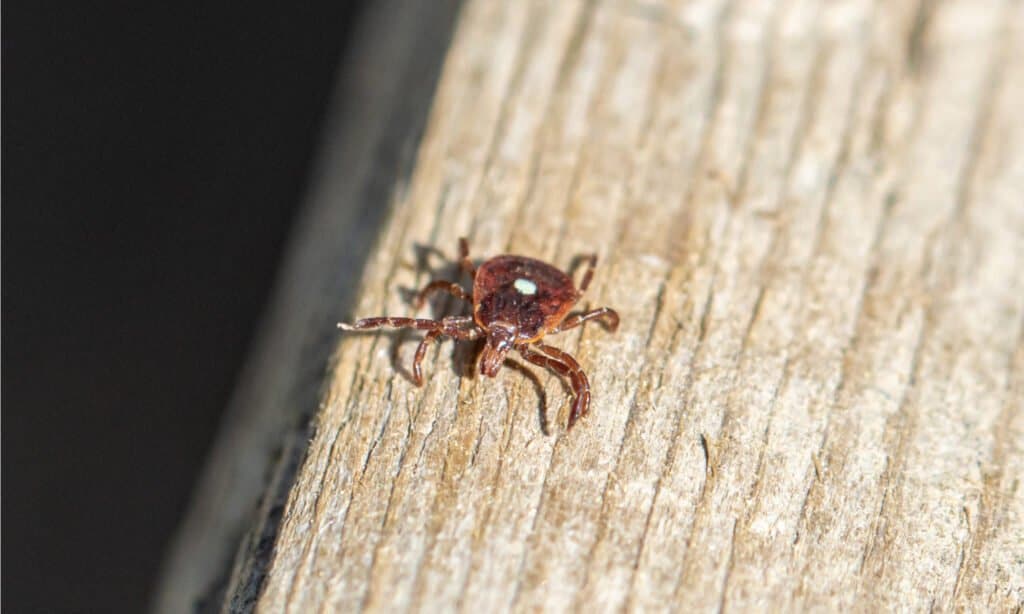Lone Star Tick
Amblyomma americanum
Only females have the ‘lone star’ marking
Advertisement
Lone Star Tick Scientific Classification
- Kingdom
- Animalia
- Phylum
- Arthropoda
- Class
- Arachnida
- Order
- Ixodida
- Family
- Ixodidae
- Genus
- Amblyomma
- Scientific Name
- Amblyomma americanum
Read our Complete Guide to Classification of Animals.
Lone Star Tick Conservation Status
Lone Star Tick Facts
- Prey
- Blood
- Name Of Young
- Larvae
- Group Behavior
- Solitary
- Fun Fact
- Only females have the ‘lone star’ marking
- Biggest Threat
- Ingestion by nematodes or mites
- Most Distinctive Feature
- Star shaped spot on female’s back
- Other Name(s)
- Northeastern water tick, turkey tick, cricker tick
- Gestation Period
- 1-30 days
- Litter Size
- 5,000 eggs
- Diet
- Omnivore
- Type
- Insect
- Common Name
- Turkey tick
- Number Of Species
- 1
- Location
- North America, Central America, South America
- Group
- Arachnid
Lone Star Tick Physical Characteristics
- Color
- Brown
- Skin Type
- Exoskeleton
- Lifespan
- 6-18 months
- Length
- 2-6 mm
- Age of Sexual Maturity
- 9-17 days
View all of the Lone Star Tick images!
“Lone star ticks were first observed in 1754 in New York.”
Ticks may be one of the most feared insects on the planet. They not only inflict painful, traumatizing bites, they’re also vectors for many serious diseases. On top of that, their bites can cause painful allergic reactions, and even make victims allergic to red meat. Lone star ticks are one of the most common species of tick in the eastern United States; they can be found all the way from Canada in the north, to South America in the south.
There are over 900 species of tick living all over the world. Of those 900 species, around 700 are in the hard-bodied, Ixodidae family, while the remaining 200 are in the soft-bodied Argasidae family. Lone Star ticks are hard-bodied and belong to the Ixodidae family of ticks. Like their hard-bodied cousin, the American dog tick, they have rounded bodies with visible heads and mouthparts.
4 Incredible Lone Star Tick Facts!
- Only female lone star ticks have the ‘lone star’ marking
- Females produce 5,000 eggs at once
- Lone star ticks have four distinct life stages
- They’re not likely to spread Lyme disease
Lone Star Tick Species, Types, and Scientific Name
The lone star tick’s scientific name is Amblyomma americanum, it was first categorized in 1758. There is only one variety of lone star tick, so named for the star shaped, white dot on the female’s back. Lone star ticks are a type of hard-bodied tick native to North America, though they have spread to Central and South America.
Appearance: How to Identify Lone Star Ticks
Lone star ticks are so small that they’re hard to see with the naked eye, especially if they’re clinging to a bush or a tall piece of grass. Their bodies are divided into three basic parts: head, abdomen, and legs.
In hard-bodied ticks, like the lone star tick, the head and mouthparts are located at the front of the body, like the cap on a bottle. Together, the head and mouthparts are known as the capitulum. The mouthparts include both the chelicerae—a pair of scissor-like cutters—and a hypostome, which we’ll learn more about later.
The lone star tick’s abdomen is partially covered in a hard, shield-like structure called a pronotum. The pronotum is much larger and more obvious in females than it is in males. The abdomen is long and rounded, like a seed. When the tick feeds, the abdomen swells up to 600 times its normal weight.
The final aspect of the lone star tick’s anatomy is its legs. Each tick is born with only six legs. As they grow, they actually develop a fourth set of legs, giving adult ticks eight legs in total. They’re members of the Arachnida class, the same class that includes eight-legged spiders. Each leg has seven segments and ends in a claw.

©Maria T Hoffman/Shutterstock.com
Life Cycle: How to Identify Lone Star Tick Eggs
Lone star ticks have a four-part life cycle: egg, larva, nymph, then adult. For each stage of life, starting as larvae, the tick seeks out a new host to feed on. Their lifespan ranges between 6-18 months, but may vary widely depending on climate and weather conditions. Similarly, each stage of life may be shortened or lengthened depending on the temperature, humidity, and availability of live hosts.
Female lone star ticks, which can be differentiated from the males by the single, ‘star’ marking on their abdomen, deposit around 5,000 eggs just once before dying. The egg mass looks like a mound of tiny, brown caviar. After incubation, the six-legged larvae hatch, and start searching for their first meal.
Lone star ticks are what’s known as a ‘three-host’ tick, meaning they take a new host for each life stage. Once they’ve fed in the larval stage, they drop off the host, molt, and find a new host as an eight-legged nymph. Then, once the nymph has fed, it again drops off, molts, and finds a host as an adult.
Habitat: Where to Find Lone Star Ticks
Lone star ticks can be found in many outdoor environments. The easiest way to find one is to walk through tall grass or brush that rubs on your clothes or skin. Ticks like to hang out at the ends of such foliage, their front pair of legs extended, just waiting for an unknowing victim to come along. They also favor the zones where woods meet open areas, like meadows.
Diet: What do Lone Star Ticks Eat?
Lone star ticks, like all species of tick, are obligate hematophages. ‘Hemato’ means blood, and ‘phage’ means to eat—you get the picture. Ticks fulfill all of their nutritional requirements from ingesting blood. Adult females, when ready to procreate, gorge themselves up to six times their normal size. Then, they drop off the host onto the ground and convert all that blood into thousands of eggs.
To feed, ticks cut a hole in the skin using their chelicerae. Then, they insert their hypostome into the hole like an anchor, and lap up the blood.
Young lone star ticks feed primarily on birds and small mammals, like mice, rats, and raccoons. Adult lone star ticks can often be found on whitetail deer, turkeys, and other medium-sized animals. They’re also known to feed on humans and dogs who pick them up during outdoor activities.
What Eats the Lone Star Tick?
Lone star ticks are very small, smaller than the head of a match. When fed, they engorge to many times their original times. As larvae and nymphs, they’re mainly eaten by mites and nematodes. Adults that try to feed on opossums are almost always eaten by the opossum when it grooms itself. They’re also eaten by birds, particularly guineafowl.
Lone Star Tick vs. Deer Tick
Deer ticks occupy many of the same spaces as lone star ticks; they’re often mistaken for one another. The easiest way to tell if you’re looking at a lone star tick is by looking for the lone star. Additionally, male lone star ticks have white, stripe-listar e markings along the edges of their abdomen that deer ticks lack. Another big difference between the two species is in the abdominal shape. Both deer and lone star ticks have rounded bodies, but the deer tick’s body is much narrower, and egg shaped, than the lone star tick’s body.
Prevention: How to Avoid Lone Star Tick Bites
Luckily, lone star ticks don’t spread Lyme disease, but they can still spread blood-borne pathogens. The simplest way to avoid a lone star tick bite is by staying out of areas where ticks are found. Basically, don’t walk through any terrain that requires you to wade through grass or shrubs. Stay on hiking trails, and out of the underbrush.
If you must scrape up against some grass and branches, be sure to wear long sleeves, long pants, and long socks. If you want even more protection—given that ticks can easily crawl up clothes to the skin—try tucking your pants into your socks, and your shirt into your pants. It may look a little silly, but what’s worse, looking silly, or pulling a tick out of your skin?
What to do if You’ve Been Bitten by a Lone Star Tick
So you’ve been bitten by a tick, what do you do now? Your first step should be to remove the tick; don’t wait until you get home, pull it out as soon as possible. Research shows that the longer the tick is embedded in your skin, the larger the potential for contracting something from it. Ticks can be removed using either tweezers or tick removal tools. Simply grasp the tick’s abdomen firmly, then pull it out, slow and steady.
Next, you’ll want to clean the wound with alcohol and monitor it for the next several days. With lone star ticks, it’s normal to develop an itchy, red spot where the bite was. But, if you also develop a fever, headache, muscle aches, or rash—seek immediate medical attention.
View all 98 animals that start with LThank you for reading! Have some feedback for us? Contact the AZ Animals editorial team.
Sources
- Center for Disease Control / Accessed March 2, 2022
- Rutgers New Jersey Agricultural Experiment Station / Accessed March 2, 2022


















